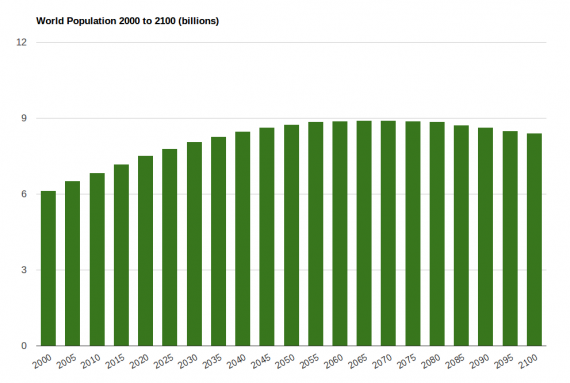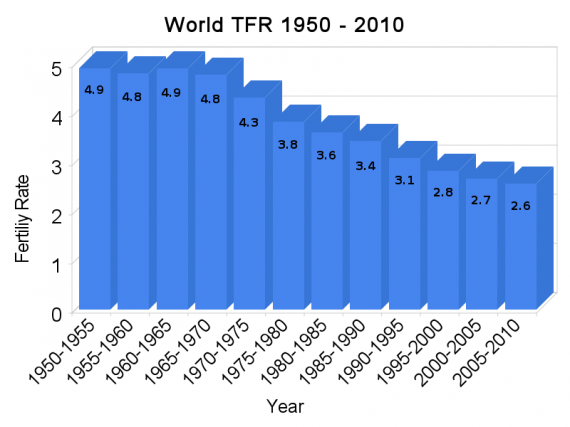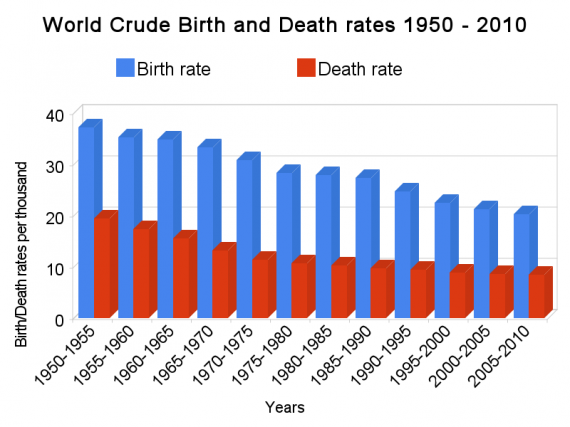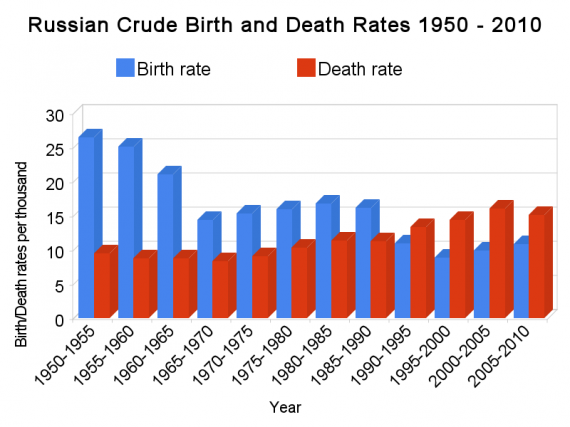In 1972, The Club of Rome published a book entitled The Limits To Growth. In the foreword, on page 11, the authors identified “the five basic factors that determine, and therefore, ultimately limit, growth on this planet,” namely:
- Population
- Agricultural Production
- Natural Resources
- Industrial Production
- Pollution
“Super”-exponential Growth
In this post I am concerned only with population. Particularly the predictions the authors of The Limits To Growth made about population. The book goes into detail about exponential growth in general and as it applies to population:
In 1650 the population numbered about 0.5 billion, and it was growing at a rate of approximately 0.3 percent per year. That corresponds to a doubling time of nearly 250 years. In 1970 the population totaled 3.6 billion and the rate of growth was 2.1 percent per year. The doubling time at this growth rate is 33 years. Thus, not only has the population been growing exponentially, but the rate of growth has also been growing. We might say that the population growth has been “super”-exponential; the population curve is rising even faster than it would if growth were strictly exponential. (“The Nature of Exponential Growth,”The Limits To Growth, 1972, 34)
Clearly, “super”-exponential sounds very frightening. Indeed, of sufficient concern to cause governments to panic and adopt policies they would not normally endorse.
Intriguingly, in 1972, when “The Limits To Growth” was published, the growth rate of population was already in decline. Since that year the population growth rate has continually decreased to a rate that is almost half of the peak.
14.4 Billion People by 2030
Another warning from the book:
…we can look forward to a world population of around 7 billion persons in 30 more years [in the year 2000]. And if we continue to succeed in lowering mortality with no better success in lowering fertility than we have accomplished in the past, in 60 years there will be four people in the world for every one person living today. (The Limits To Growth, 38)
Taking the population as of 1970, which was 3.6 billion, and multiplying by 4, we arrive 60 years hence in 2030 with a predicted population of 14.4 billion people.
Now, using numbers from the International Institute for Applied Systems Analysis (IIASA), let us see where the population was in 2000 and look at projections to the year 2100. I am using the IIASA estimates because they closely align with the United Nations medium variant but go beyond 2050.
Population Growth Chart and Table
| Year | Population | Year | Population |
|---|---|---|---|
| 2000 | 6.12 | 2050 | 8.75 |
| 2005 | 6.51 | 2055 | 8.85 |
| 2010 | 6.82 | 2060 | 8.87 |
| 2015 | 7.17 | 2065 | 8.90 |
| 2020 | 7.51 | 2070 | 8.89 |
| 2025 | 7.79 | 2075 | 8.87 |
| 2030 | 8.05 | 2080 | 8.85 |
| 2035 | 8.26 | 2085 | 8.72 |
| 2040 | 8.47 | 2090 | 8.62 |
| 2045 | 8.63 | 2095 | 8.50 |
| 2100 | 8.39 |
Population in billions
Conclusions
Notice that the 2000 population prediction was off by one billion less. The 14.4 billion forecast in 2030 will not be reached with less than 19 years left. The current IIASA projection is for a population peak that is just shy of 9 billion by 2068. Thus the prediction from The Limits To Growth will come up short by a huge 5.4 billion people.
Granted, I am using a current projection to discredit a past projection. However, the record so far is to overestimate population growth. For example, China’s population is projected to peak at less than 1.4 billion in 2026, both earlier and at a lower level than previously projected.
I expect to see further revisions downward in the projections of population growth. Fertility rates have been falling for over sixty years and demographic momentum will shrink the world’s population just as quickly as it contributed to rapid growth.
We must not let outfits such as The Club of Rome dictate to governments unwise population policies based on dubious and inaccurate predictions of the future.
External Articles
This list is updated occasionally, with newer additions listed first.
- Korea’s Total Fertility Rate Still Near the Bottom of the World — Ranks 217th among 222 countries.
- Five myths about global population — Dispensing with some of the most common misconceptions.
- 7 Billion People: What Population Control Advocates Don’t Say — Global fertility rates cut in half.
- The End of Population Growth — Peak likely at 9 billion in the 2050’s.
- Brazil’s Girl Power — Brazilian fertility rate is below the level at which a population replaces itself.
- Taiwanese birth rate plummets despite measures — Taiwan has the world’s lowest fertility rate.
- Economic turmoil taking its toll on childbearing — 18.8% of U.S. women ages 40-44 are childless.
- The Problems of a Graying Population — The answer is to persuade families to have more children.
- Cities built for young brace for aging public — By 2050, 1 in 5 Americans will be seniors.
- Aging population rises while savings rate falls — Sri Lanka’s aging population is increasing.
- Cuba’s Population Shrinking, Growing Old — Cuba is on course to dip below 11 million in 2032.
- Beyond a Demographic Point of No Return — Elder dependent ratio will rise to over 60%.
- Malawi fertility rate dropping — Total Fertility Rate has decreased by 0.6 percent.
- A decline in U.S. births since 2007 — CDC reports 2010 births were 7 percent less than 2007.
- The Long View of Feeding the Planet — Food-related climate doom has no historical foundation.
- Population Implosion? — Government policies can slow fertility declines.
- Older and wiser? — China scrambling to cope with the changing shape of its population.






